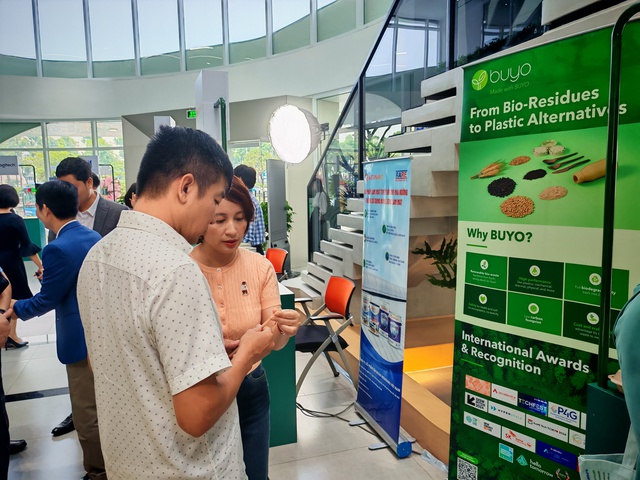
Vietnam’s miracle transformation: From rice fields to global green powerhouse
No longer merely a 'low-cost factory,' Vietnam is redefining itself as a hub of green innovation where farmers generate clean electricity, small businesses access global markets, and the Net Zero 2050 commitment takes shape through technology and policy.
As the world shifts from cheap manufacturing to sustainable production, Vietnam is asserting a new role: not only producing but also leading a regional green revolution.
From agrivoltaic farming models to digitally integrated supply chains, the country’s transformation is being driven by clear policies, breakthrough technologies, and a strong grassroots spirit of innovation.
The insights, figures, and expert quotations presented in this article are based on discussions from the Open Innovation Day 2025, held on October 25-26 in Ho Chi Minh City as a forum bringing together policymakers, scientists, and business leaders to chart Vietnam’s green innovation future.
Policy and agrivoltaics: Foundation of green transformation
Vietnam’s national energy policy has been firmly aligned with its Net Zero 2050 commitment.
According to Dr. Nguyen Van Hoi, director of the Vietnam Institute of Strategy and Policy for Industry and Trade under the Ministry of Industry and Trade, all policies and strategies must serve this long-term goal, ensuring that domestic energy development follows the principles of sustainability, efficiency, and environmental responsibility.
The prime minister has approved numerous strategies that integrate energy transition goals into industrial regulations, creating ripple effects from production to export.
Dao Hung Anh, director of Hoa Nam Energy, highlighted three core priorities: achieving Net Zero by 2050, ensuring transparent environmental, social, and governance reporting, and adopting a green taxonomy while adapting to global carbon border mechanisms such as the EU’s Carbon Border Adjustment Mechanism.
“These standards will soon shape not only Vietnam but also the regional market,” he said, emphasizing that industries like steel and cement must transition urgently.
He cited the example of Hoa Phat Group’s 'green steel' model, which has received carbon certification and reduced energy costs.
The standout breakthrough is agrivoltaics, the combination of agriculture and solar power. As Dao Hung Anh explained, Vietnam’s challenge is not just growth, but inclusive growth.
“We must create new income sources for farmers," Anh said.
"Agrivoltaics enables them to produce both crops and clean energy, dramatically increasing land-use efficiency.
"This is not only an energy solution but also a sustainable business model.”
Dr. Hoi from the Vietnam Institute of Strategy and Policy for Industry and Trade added, “We can think of this hybrid agro-industrial model as a family ecosystem: the ‘father’ represents industry, providing structure and productivity, while the ‘children’ represent energy -- dynamic, renewable, and ever-evolving.”
One example of innovation through public-private partnership (PPP) is the CAS FARM model.
Nguyen Ngoc Duong, business development director at CAS Energy, noted this green livestock farm model shows how PPP-based innovation can thrive.
However, the current policy framework still lags behind reality. Clearer guidelines are urgently needed on hybrid land use, carbon accounting, and benefit-sharing mechanisms.

Buyo's showcase kiot during Open Innovation Day 2025 in Ho Chi Minh City on October 25-26, 2025. Buyo is a pioneering Vietnamese startup transforming agricultural and food waste into 100% biodegradable bioplastic. Photo: Kim Thoa / Tuoi Tre News
Digitalization and integration: From foundation to market
To reach Net Zero, Vietnam will require about US$130 billion in green infrastructure investment.
Decrees 56, 57, and 58 have set strategic directions, but according to Dao Hung Anh, they remain broad frameworks.
“We still lack clear implementation guidelines for domestic businesses and foreign investors,” Anh said.
The national grid is under strain due to limited investment in transmission capacity. State utility Vietnam Electricity (EVN) and the Ministry of Industry and Trade have approved a plan for 2,400 MW of energy storage, in partnership with Huawei, scheduled to be operational by 2026.
William Taing, managing director of Beanstalk AgTech, remarked: “These are massive projects with inherent risks. The next three to five years will demand major breakthroughs in smart energy infrastructure and expanded PPPs to accelerate the sustainable transition.”
Vietnam’s transformation extends beyond its borders through digitalization and integration into global supply chains.
Vu Xuan Linh, director of strategic partnerships at Shopee, observed: “We believe cross-border e-commerce will grow rapidly. Yet we’re still in an early stage where speed is crucial. Businesses that hesitate risk being left behind.”
The Shopee International Platform supports Vietnamese enterprises in overcoming export barriers, such as logistics, customs, payment, and market regulations.
“E-commerce isn’t just a sales channel," said Timen R. ter Meulen Swijtink, founder of Lacàph Coffee Vietnam.
"It’s a real-time learning platform for Vietnamese brands to grow and strengthen their global presence.”
He urged Vietnamese companies to collaborate with professional branding agencies, meet global standards such as U.S. Food and Drug Administration requirements, and use e-commerce platforms as testbeds for international expansion.
Artificial intelligence is also reshaping how businesses forecast markets and manage supply chains. Kha Phan of Easy AI illustrated this with an example: a Vietnamese company exporting rice to Bangladesh and West Asia.
“When Bangladesh recently allowed duty-free imports of 500,000 metric tons of rice, timing became critical," Phan pointed out.
"AI can analyze market signals, forecast demand, and recommend the optimal export window, helping companies respond quickly and efficiently.”
He stressed that AI adoption must start with data integrity and compliance.
Four guiding principles include compliance before computation (per Decree 30), regular model verification, human oversight in sensitive cases, and starting small with smart scaling based on clear KPIs.

Many experts shared their insights at Open Innovation Day 2025 in Ho Chi Minh City on October 25-26, 2025, in the hope of helping Vietnam find feasible solutions for its digital and green transition roadmap. Photo: Kim Thoa / Tuoi Tre News
Challenges remain: policies need more detailed frameworks, infrastructure requires stronger investment, and human capacity must be enhanced.
Yet with its Net Zero 2050 commitment, coherent policy-to-technology support, and a vibrant culture of innovation, from enterprises to farmers, Vietnam is steadily positioning itself as an indispensable player in the global green innovation ecosystem.
It is a nation not only participating in but also leading the sustainable production revolution.
Two-part electricity tariff system: A key to unlocking green investment
In its energy transition, Vietnam is considering the adoption of a two-part electricity tariff system, a mechanism separating power prices into fixed charges (based on capacity) and variable charges (based on actual consumption).
This approach ensures a stable revenue stream for EVN, enabling continued investment in grid infrastructure, while encouraging businesses to optimize electricity use during peak and off-peak hours.
It is a crucial step toward building a smart grid, effectively integrating renewable energy, and attracting private investment in green energy infrastructure -- key pillars for achieving Vietnam’s Net Zero 2050 target.
Kim Thoa / Tuoi Tre news
Link nội dung: https://news.tuoitre.vn/vietnams-miracle-transformation-from-rice-fields-to-global-green-powerhouse-103251029173441662.htm